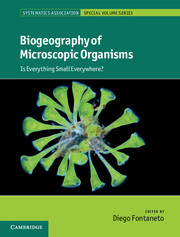Book contents
- Frontmatter
- Contents
- List of contributors
- Preface
- Part I Theoretical framework
- Part II Prokaryotes
- Part III Unicellular eukaryotes
- Part IV Pluricellular eukaryotes
- 9 Coalescent analyses reveal contrasting patterns of intercontinental gene flow in arctic-alpine and boreal-temperate fungi
- 10 Biogeography and phylogeography of lichen fungi and their photobionts
- 11 Biogeography of mosses and allies: does size matter?
- 12 Dispersal limitation or habitat quality – what shapes the distribution ranges of ferns?
- 13 Ubiquity of microscopic animals? Evidence from the morphological approach in species identification
- 14 Molecular approach to micrometazoans. Are they here, there and everywhere?
- Part V Processes
- Index
- Systematics Association Publications
- Systematics Association Special Volumes
- Plate section
- References
14 - Molecular approach to micrometazoans. Are they here, there and everywhere?
from Part IV - Pluricellular eukaryotes
Published online by Cambridge University Press: 05 August 2012
- Frontmatter
- Contents
- List of contributors
- Preface
- Part I Theoretical framework
- Part II Prokaryotes
- Part III Unicellular eukaryotes
- Part IV Pluricellular eukaryotes
- 9 Coalescent analyses reveal contrasting patterns of intercontinental gene flow in arctic-alpine and boreal-temperate fungi
- 10 Biogeography and phylogeography of lichen fungi and their photobionts
- 11 Biogeography of mosses and allies: does size matter?
- 12 Dispersal limitation or habitat quality – what shapes the distribution ranges of ferns?
- 13 Ubiquity of microscopic animals? Evidence from the morphological approach in species identification
- 14 Molecular approach to micrometazoans. Are they here, there and everywhere?
- Part V Processes
- Index
- Systematics Association Publications
- Systematics Association Special Volumes
- Plate section
- References
Summary
Introduction
The ‘Everything is everywhere, but the environment selects’ hypothesis (EiE hereafter) was originally proposed to explain the apparent ubiquity of microorganisms based on evidence from bacteria (Beijerinck, 1913). Recently, this has been proposed also for protists (e.g. Fenchel and Finlay, 2004) and further extended to micrometazoans (animals smaller than 2 mm) (Foissner, 2006). This hypothesis assumes that microorganisms disperse worldwide due to their microscopic sizes and dormancy capabilities, and that their distributions are restricted only by environmental limitations. High local:global diversity ratios for species assemblages and high gene flow between populations are thus expected. Micrometazoans share a common evolutionary history and the multicellular condition with macroscopic animals, while they are similar in terms of resources used, microscopic size and dormancy capability to microscopic unicellular organisms, which are supposed to be without biogeographies. Even though micrometazoans may provide interesting evidence for the EiE hypothesis, their diversity and phylogeography has not received much attention. However, results so far (which we will deal with along the chapter) give us some indications of ecological and historical–geographic influence on micrometazoan distributions.
Little is known about distributional patterns and phylogeography in micrometazoans – as yet they neither support nor reject the EiE hypothesis. However, the few studies using a molecular approach are providing useful results on micrometazoan patterns, cryptic species and phylogeography.
- Type
- Chapter
- Information
- Biogeography of Microscopic OrganismsIs Everything Small Everywhere?, pp. 284 - 306Publisher: Cambridge University PressPrint publication year: 2011
References
- 18
- Cited by



